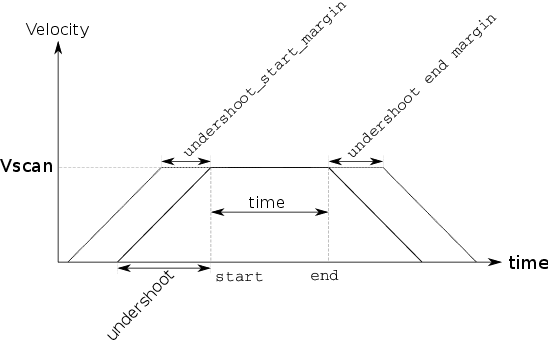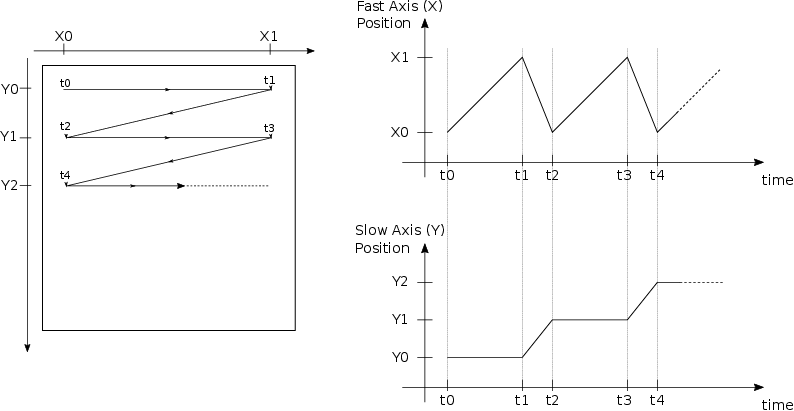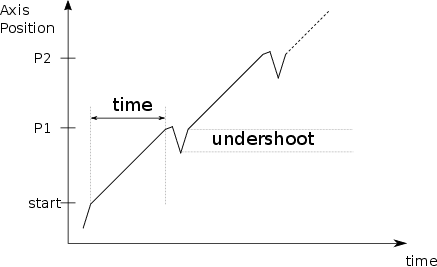Acquisition Master/Device
Those objects describe the behavior you need in a scan of basic device (axis, counters…) in therm of triggering and data flow. Those objects can be:
mastermeans that can trigger other devicedeviceany data producer device
Master¶
motors¶
The exhaustive list of motor master are available in
bliss.scanning.acquisition.motor
MotorMaster¶
from bliss.scanning.acquisition.motor import MotorMaster master = MotorMaster(axis, # axis you want to drive start, end, time=0, undershoot=None, # leave it to None to let it calculated undershoot_start_margin=0, undershoot_end_margin=0, backnforth=False)
-
Drives one motor from a
startposition to aendposition at a constant speed. -
If
undershootis None, it is calculated according the acceleration of the motor. -
undershoot_start_marginandundershoot_end_margincan be added to the calculated undershoot. -
backnforthoption will do every even motions in one direction and odd motions in the other direction.

SoftwarePositionTriggerMaster¶
- Drives the axis the same way as the
MotorMaster. - Sends a software trigger to slaves for each step position between start position and end position
from bliss.scanning.acquisition.motor import SoftwarePositionTriggerMaster master = SoftwarePositionTriggerMaster( axis, start, end, npoints=1, #number of trigger between start and end position time=0, undershoot=None, # leave it to None to let it calculated undershoot_start_margin=0, undershoot_end_margin=0, backnforth=False)
JogMotorMaster¶
On some motor controller, to reach the top speed, you need to drive it
in speed instead of position. You may need this master to achive
that. This master helper will calculate for you the undershoot
needed to reach the jog_speed at the start position. In case
of margin, just add or subtract the position value to your start
position.
-
jog_speedis sign to control the rotation clockwise or counterclockwise. -
To end the movement:
- either you stop externally the axis
- or you may provide a
end_jog_functionfunction which will be called during the motion. The return of this function will end the movement if it does not returnTrue.
from bliss.scanning.acquisition.motor import JogMotorMaster def end_jog_function(axis): """ This function will ends the movement if returns != True. """ return axis.position < 720. master = JogMotorMaster(axis, start, jog_speed, end_jog_function=end_jog_function)
MeshStepTriggerMaster¶
Control from 2 to n motors to drive them during a mesh step scan. This master will build a position grid for all axis. Arguments passed to this object is a list of: axis,start_position,end_position,nb_points.
i.e: a 2D mesh can be written as follow:
from bliss.scanning.acquisition.motor import MeshStepTriggerMaster master = MeshStepTriggerMaster(axis1,0,1,5, axis2,-1,1,10)
In this example axis1 will be the fast axis => it will move on any step. axis1 will be move every 5 steps… In short axis1 is the column axis and axis2 is the line axis.
for a 3D mesh:
from bliss.scanning.acquisition.motor import MeshStepTriggerMaster master = MeshStepTriggerMaster(axis1,0,1,5, # fast axis axis2,-1,1,10, axis3,-2,2,20) # slowest axis
backnforth can be activated to do a snake style mesh. i.e: in a case of 2D mesh odd lines are scanned in one direction and even are scanned in the other direction.
LinearStepTriggerMaster¶
Drive axis across a n dimensional line like anscan command. Argument of the master are:
- first argument the number of points
- then a triplet with axis instance follow by the start position and the end position
To drive two axis here is an example:
from bliss.scanning.acquisition.motor import LinearStepTriggerMaster nb_points = 20 master = LinearStepTriggerMaster(nb_points, axis1,0,10, axis2,-1,1)
VariableStepTriggerMaster¶
Generic motor master for arbitrary step by step acquisition. Positions are provided via a iterable object like list, numpy array… Argument for this master is a couple of axis followed by an iterable position object.
Note
All motors should have the same amount of positions.
Here is a example to do a arc scan of 90 points from -45 deg to 45 deg with rayon of 5 with first axis X and second axis Y.
import numpy from bliss.scanning.acquisition.motor import VariableStepTriggerMaster rayon = 5 angles = numpy.linspace(-45,45,90) x_positions = rayon * numpy.cos(numpy.deg2rad(angles)) y_positions = rayon * numpy.sin(numpy.deg2rad(angles)) master = VariableStepTriggerMaster(X, x_positions, Y, y_positions)
CalcAxisTrajectoryMaster¶
When real axis of a calculation axis have a motor controller with trajectory
capable, you can use this master to automatically calculate trajectory
of real motors. It has the same behavior of the MotorMaster but on a
calculation axis => constant speed on the calculation axis.
from bliss.scanning.acquisition.motor import CalcAxisTrajectoryMaster master = CalcAxisTrajectoryMaster(calc_axis, start, #start position end, #end position nb_points, # nb sampling point for trajectory time_per_point)
Warning
nb_points define the sampling for the final trajectory. This will determine it’s precision. It will be the number of points loaded into the motor controller.
MeshTrajectoryMaster¶
This master control 2 axis to program a mesh trajectory on a motor controller capabale.

from bliss.scanning.acquisition.motor import MeshTrajectoryMaster master = MeshTrajectoryMaster( X, # axis instance for colums X0, # first column position Xend, # last column position nb_columns, # number of point on column Y, #axis instance for lines Y0, # first line position Yend, # last line position time_per_point, undershoot = None, # if None calculate it with the axes acceleration undershoot_start_margin=0, # margin before 1st column position for each line undershoot_end_margin=0 # margin at the end of each line)
Note
undershoot, undershoot_start_margin and undershoot_end_margin are
for each line of the mesh. Same meaning as MotorMaster
variables.
SweepMotorMaster¶
Main usage of this master is to deal with a camera with a high dead
time. This dead time prevents you to acquire images during only one
motion (like MotorMaster) because the gaps between images are to
high. This master splits a continous motion into several, basically one
motion per image. Final motion looks like:

One the first iteration, the motion is at constant speed between
start position and P1, then the second iteration rewind the axis
and restart an other motion and reach the constant between P1 and
P2… and so one until end position. The number of movement is
defined by the npoints. time defines the elapsed time between points.
from bliss.scanning.acquisition.motor import SweepMotorMaster master = SweepMotorMaster( axis, # axis instance start, # first point position end, # last point position npoints=1, # number of points (images) time=0, # see above schema undershoot=None, # if None calculated with axis acceleration undershoot_start_margin=0, undershoot_end_margin=0)
Note
undershoot, undershoot_start_margin and undershoot_end_margin are
for each point (images). Same meaning as MotorMaster
variables.